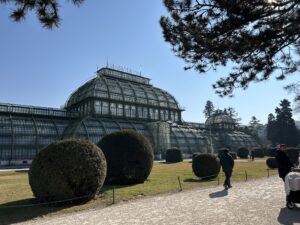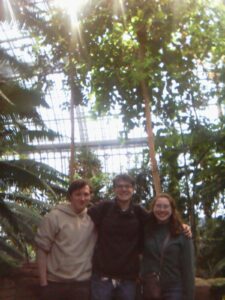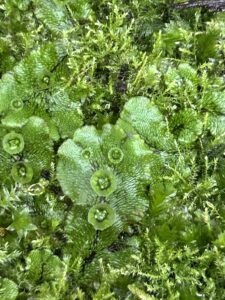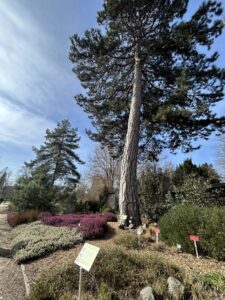Botanical Buffoonery
History and Importance of Botanical Gardens
Modern botanical gardens’ primary objective is to display a plethora of plants labelled with common and scientific names. Often the plants are organized based on the genus, species or their scientific relationships. Botanical gardens stemmed from places in ancient China and the Mediterranean which cultivated fruit trees, vegetables, and herbs. These gardens were often intertwined with ancient medicinal uses. The link between botanical gardens and medicine continued into the 1500’s where they were established in Europe mainly in association with medical professors. In the 18th and 19th century the science of botany emerged with “…1,600 botanical gardens in Europe” by the end of the 18th century (Botanical Garden | Plant Conservation, Education & Research, 2025).

Currently botanical gardens are led by botanists with a focus on ornamental plants and flora groups of interest. They serve to teach the public about plants and offer greater access to unique plants. Larger botanical garden collections also still provide a great resource for professional scholars. Many that are affiliated with universities also have libraries and labs. Some botanical gardens such as the ones in Kew, Edinburgh and the Royal Horticultural Society’s garden at Wisley are famous for training gardeners. Botanical gardens also play an important role in horticulture and the breeding of new plants. England’s Royal Botanic Gardens at Kew are famous for distributing plants which now serve important economic roles like “… the rubber tree, pineapple, banana, tea, coffee, cacao, various timbers, and cinchona (yielding quinine) and other drug producers” (Botanical Garden | Plant Conservation, Education & Research, 2025).
Botanical gardens will also be increasingly important as climate change continues. With biodiversity decreasing and plant life being threatened, preserving plant species is crucial. Due to deforestation, exploitation and unsustainable agricultural practices, “The threat of extinction affects about one-third of the world’s vascular plant species” (Prasanna, 2024). Botanical gardens are just one conservation resource which can be used in the fight to maintain plant biodiversity. They play a huge part in protecting plant species around the world; “Over 41 percent of known threatened species have been conserved by the 3,269 botanical institutions spread over 180 nations, and at least 30 percent of all plant species’ variety is thought to have been preserved” (Prasanna, 2024). Also, botanical gardens in cities offer green space in urban environments which has numerous benefits. Some of which include better reported quality of life for nearby residents, mitigating the urban heat island effect, and helping with stormwater management.
My Experiences
During my time in Europe this semester I visited five botanical gardens. I went to the ones in Bonn, Copenhagen, Vienna, Berlin and Munich. Throughout my lifetime I have been to quite a few more. Some unique features that differ between the botanical gardens are butterfly rooms, the size of the outdoor gardens, the themes of rooms they include in the greenhouse area, and some even have living organisms like frogs within the flora. Though these features can set them apart, most botanical gardens have many similarities. They all have plants labelled with their scientific names, tropical plants, a greenhouse area, and an outdoor park with native and non-native plants.


The Bonn botanical garden is one of my favorites. It is such a peaceful place with a great collection of plants both within the greenhouse and the outdoor area with “Around 10,000 plant species from 388 plant families” (Welcome to the Botanic Gardens, n.d.). The garden has existed since the early 1700’s and it has contributed to “… research and teaching for more than 200 years” (Welcome to the Botanic Gardens, n.d.). The aquatic plant room and the cactus room are quite wonderful. Also, they have a really cool patch of liverwort, which is a type of non-vascular land plant (similar to mosses and who reproduce using spores). Liverwort is also particularly fascinating because, “The most ancient liverwort fossils known provide the earliest evidence of plants colonizing the land” (Botanical Garden | Plant Conservation, Education & Research, 2025). I visited the Bonn botanical garden once in winter during its limited hours, once on my birthday and twice in the spring. The greenhouse area changed only slightly, with some minor plants switched out. The outdoor area changed the most in the springtime with many flowering plants in full bloom. The gardens also have a good staghorn fern collection.



There were also highlights from other botanical gardens. The Copenhagen garden had a very large and architecturally beautiful greenhouse. There was also a nice butterfly room. The Vienna botanical gardens were very nice. They had a desert area which had tortoises, desert mice and naked mole rats. Also the greenhouse building was full of flowers. The Berlin botanical gardens have a wonderful outdoor area. We went while it was snowing and saw a fox. The Munich botanical gardens had the best butterfly room I have been to. There were so many flying around with many different species represented. Also they had many unique species of orchids.

~ Maya
References
Botanical garden | Plant Conservation, Education & Research. (2025, March 31). Britannica. Retrieved April 23, 2025, from https://www.britannica.com/science/botanical-garden-study-and-exhibition-garden
Prasanna, D. (2024, June 24). An Overview of the Scientific Significance of Botanical Gardens in Plant Conservation. International Journal of Botany Studies. Retrieved April 23, 2025, from https://www.botanyjournals.com/assets/archives/2024/vol9issue6/9056.pdf
Welcome to the Botanic Gardens. (n.d.). Universität Bonn Botanic Gardens. Retrieved April 23, 2025, from https://www.botgart.uni-bonn.de/en

Impressive. I wonder how many are in your back yard in Maine?
Golly Gee! I love nature and plants so these would be great places for me to make a visit. Which one was your least favorite garden so I can stay as fay away as possible??
-Godspeed,
Winston Smith